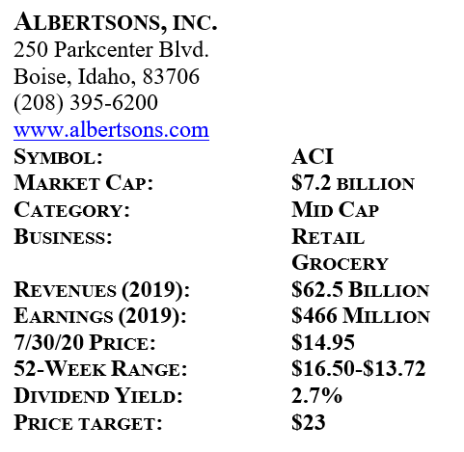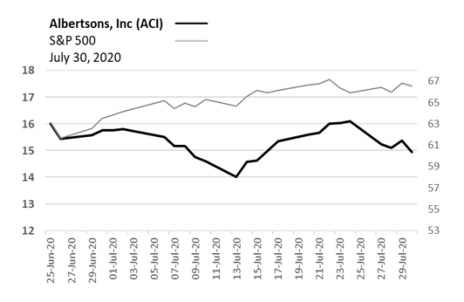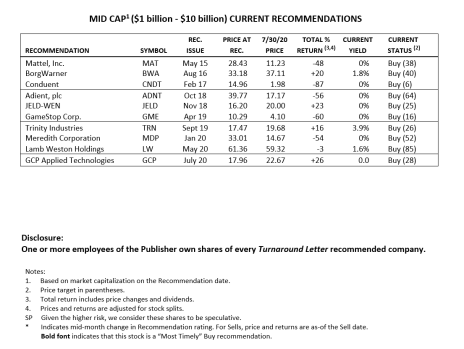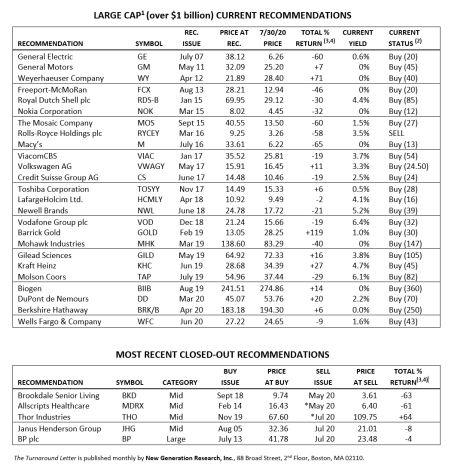This year, individual stock performance has largely been driven by a single narrative: how well the underlying companies are positioned for a pandemic-striken world. Those with strong digital-economy businesses have surged, while those with physical-economy businesses have stalled, or worse.
In this issue we recommend a life insurance stock and talk about Dow laggards with rebound potential.
Cabot Turnaround Letter 820
DOW JONES LAGGARDS THAT COULD RETURN TO FAVOR
In This Issue:
Dow Laggards with Rebound Potential
Life Insurance Stocks
Recommendations:
Buy: Albertsons, Inc. (ACI)
Price Target Changes and Sells
Performance Charts
This year, individual stock performance has largely been driven by a single narrative: how well the underlying companies are positioned for a pandemic-striken world. Those with strong digital-economy businesses have surged, while those with physical-economy businesses have stalled, or worse. In many ways, it is similar to the dot-com market over two decades ago, which split into “new economy” and “old economy” stocks. This bifurcation can be readily seen among the 30 stocks in the Dow Jones Industrial Average. Year-to-date price changes of its members range from Microsoft (+29%) and Apple (+31%) to Boeing (?50%) and ExxonMobil (-40%).
While this narrative may be compelling today, the future is, of course, unpredictable. Not only is the pandemic’s outcome still unknowable (itself a prime example of unpredictability), the upcoming presidential election, global ‘great powers’ geopolitical tensions, loose fiscal and monetary policies and other factors remain wildcards that could sharply change the narrative. It takes only a little imagination to see a world in which an effective vaccine or public ingenuity restores everyday life to a more even digital/physical balance. Today’s ‘obvious’ winners could readily become tomorrow’s laggards.
Listed below are among the worst stocks in the Dow that could return to favor. We also offer some comments on what might weigh down the winners, but suggest that readers don’t short-sell these, with Keynes’ reminder that “the market can remain irrational longer than you can remain solvent”.
The Boeing Company (BA) – If any stock deserves the rank of “weakest of the Dow,” it is Boeing. The shares have fallen more than 60% from their 2019 peak of 440. Its 737 MAX issues, market share losses to Airbus, uninspiring outlook for its new 777X, the pandemic-related collapse of air travel and jet demand, and its large $37 billion in debt may add up to a grave threat to Boeing. Yet, none of this is news to investors. BA shares are high-risk and not for the faint of heart. But if any of the numerous concerns lessen, or if rising global tensions boost demand for its defense products, the shares could rise again.
Dow, Inc. (DOW) – Dow is the world’s largest producer of ethylene/polyethylene, the most widely-used commodity plastics. In 2017, Dow merged with DuPont to create DowDuPont, and then split into three parts in 2019 based on the newly-combined product lines. The company’s near-term outlook and share price are pressured by the sharp economic decline, reflected in its 2nd quarter results. However, Dow is slashing its expenses and continues to generate sizeable cash flow. Its liquidity and balance sheet remain sturdy, and the company appears committed to and capable of retaining its generous dividend.
JPMorgan (JPM) – JPMorgan is considered the premier-quality bank in the United States, headed by one of the economy’s most capable executives. In an industry increasingly driven by technology, the bank has built a strong lead that will hinder its competitors. Its core profits (excluding credit losses) are higher despite the pandemic and low interest rates, while its large reserves and sturdy capital base prepare it for nearly all credit scenarios. As clarity around its credit losses begins to emerge elsewhere, its lagging shares and appealing 3.7% dividend yield could look increasingly attractive.
Raytheon Technologies (RTX) – After divesting its Otis elevator and Carrier air conditioning operations, United Technologies combined with Raytheon in April to form this focused aerospace and defense company. The new company should be able to generate cost-savings and boost its negotiating power. While its commercial jet operations will be pressured by weak jet travel due to the pandemic, Pratt & Whitney’s jet engine operations have no 737 MAX exposure, and both P&W and Collins Aerospace have significant and otherwise steady aftermarket revenues. The defense business, which focuses on missile defense, space militarization and information technologies, is integrally involved with key military programs and may see longer-term growth as global tensions increase. Raytheon’s weak shares may be poised for take-off.
Walgreens Boots Alliance (WBA) – With its domestic retail pharmacy market now saturated, new entrants pressuring its once-enviable position, and drug pricing and healthcare delivery changing the competitive landscape, Walgreens is searching for new sources of growth. Much was to come from acquisitions, including taking a 27% stake in pharmacy wholesaler Amerisource Bergen in 2013, its 2014 combination with Europe-based retail pharmacy chain Alliance Boots, a mail order joint venture and its purchase of 1,932 Rite Aid stores in 2018. While this produced a pharmacy retailing and distribution giant, with over 18,750 stores in North America and Europe, it hasn’t produced much growth, yet has left the company with $16.5 billion in debt.
However, change may be coming: earlier this week the long-time CEO announced his departure. With its share price unchanged for 20 years, trading at 7.6x estimated 2021 earnings, and providing a reasonably secure 4.6% yield, the shares have interesting potential.
Leaders That May Be Vulnerable
Apple (AAPL) – Apple’s iconic and well-defended products and services, along with its wide margins and vast cash flow, is the hoped-for endgame of most technology companies. Its pricey valuation is similarly envious. Yet, despite its strong 3rd quarter results, the company’s remarkable growth must eventually reach a limit based on the global market size, which would likely reverse its share price surge.
Home Depot (HD) – With people spending a lot more time in their homes, many are finding that improvements are in order. This trend could help Home Depot generate improved earnings growth for years to come. However, with its high 26.1x earnings multiple, and possible disappointments if consumers opt for travel and entertainment once the economy fully re-opens, HD shares may slip in the Dow Jones rankings.
Microsoft (MSFT) – There is little doubt that Microsoft is well-managed and well-positioned for the digitized economy. But the company needs to add a massive $50 billion in annual revenues and $18 billion in annual earnings to meet its 2023 estimates. And, it will need to add even more in future years to maintain its then-forward growth rate. For reference, IBM’s total revenues this year will be about $75 billion. Not achieving this tall order may pressure its stock, which is trading at 31.6x forward earnings.
INTERESTING LIFE INSURANCE STOCKS: MAYBE NOT AN OXYMORON
Life insurance companies are often considered to be rather dull. It seems that the only time they become exciting is during market crashes, when the drop in their investment portfolios threatens their balance sheets and solvency. Compounding their lack of shine, the industry is highly competitive and mature with profits that are vulnerable to now-pervasive low interest rates.
New near-term worries include elevated losses from Covid-related mortality and suppressed revenue growth as social distancing practices make selling policies more difficult.
Yet, the life insurance industry is in much better shape today than during the financial crisis a decade ago. Liquidity and capital levels are healthier, companies have better-hedged their market exposures, and products have lower-risk benefit structures. The equity market recovery, along with the Fed’s support of the bond market, dampens another source of historical risk.
Importantly, the near-term mortality and revenue growth issues should fade next year. Furthermore, industry pricing has remained rational. If inflation rises, as many analysts expect, any related increases in interest rates would provide a margin-lifting tailwind to life insurance companies.
Despite these favorable developments, the group appears to be heavily discounted by investors. Several life insurance companies sell at five times earnings or less, whereas they usually sell at mid-upper single digit multiples. It may seem uninspiring to buy a stock with multiple expansion potential of only 2-3 times, but when the starting position is 5, this can lead to large gains. Listed below are six relatively shiny life insurance company stocks:
Athene Holding Ltd (ATH) – This company was formed in 2009 by the former head of SunLife America and a former Bear Stearns executive, with backing by private equity firm Apollo Global Management. Athene completed its initial public offering in 2016 at $40. After an additional $1.6 billion investment, Apollo currently owns 35% of Athene, while Athene owns about 7% of Apollo. Athene views its business as acquiring others’ liabilities and managing them more efficiently. It is expanding beyond its base of core retirement income products into more complex operations like reinsurance (led by its recent Jackson National transaction) and pension plan acquisitions. The company has a sturdy capital base and appears well-managed. A major risk would be a sizeable weakening of credit market conditions. This unusual company has interesting appeal.
Equitable Holdings (EQH) – This company returned to public ownership after its partial spin-off in 2018 from European financial conglomerate AXA. Equitable is also the 65% majority owner of investment research and management firm Alliance Bernstein. Investors worry that the company’s large mix of variable annuities leaves it exposed to any weakness in equity and fixed income markets, among other issues. But Equitable has shown that it can effectively hedge its market risk, and holds considerable excess capital that it is returning to shareholders through repurchases and dividends. This stock could be the hidden gem in the group.
Globe Life (GL) – Formerly known as Torchmark, Globe Life has generated healthy profitability and earnings growth, driven by its narrow focus, efficient exclusive-agent sales network and solid expense controls. Its emphasis on plain life and health insurance produces a predictable and low-risk profile, although its bond portfolio carries modestly higher but manageable credit risk. Capital levels are strong but not excessive, reflecting its lower insurance risks. Covid-related claims will weigh on results, but Globe Life should continue to produce decent profits and cash flow, nonetheless.
Lincoln National (LNC) – The specter of the 2009 financial crisis, from which Lincoln narrowly escaped, still hangs over the company. Investors today also worry about Lincoln’s high mix of variable annuities and exposure to falling interest rates, along with elevated Covid claims. However, the company is reasonably well-capitalized, has strong liquidity and a lower risk profile, including a more effective hedging program. Lincoln’s depressed share price appears to overly discount the perceived risks.
Prudential Financial (PRU) – While “The Rock” oversees a major U.S. insurance business, its international operations are just as large at 43% of total earnings. The remaining 13% of earnings is produced by PGIM, the $1.3 trillion (assets under management) investment business.
While near-term profits will be subdued, particularly from Covid claims and low interest rates, its return on equity will likely return to a 10+% rate. New initiatives like its (expensive) AssuranceIQ acquisition should boost its on-line marketing capabilities. Prudential has excess capital and plenty of cash flow to support its unusually generous dividend yield.
Reinsurance Group of America (RGA) – This highly-regarded firm is essentially an insurance company for other life and health insurance companies. RGA’s scope is global, holding a top-3 position in major regional markets. It has steadily grown its book value per share at a 12.5% rate over the past decade. Recently, the company has expanded into newer product categories including reinsurance against market risks (which it can hedge more efficiently) and morbidity (health risks). RGA’s capital level, liquidity and cash flows remain robust. Near-term results will remain weak as the company is particularly vulnerable to Covid claims, yet this temporary expense has driven its shares down sharply. New shareholders would also benefit from the recent equity raise which boosted capital levels but weighed on the share price.
Purchase Recommendation: Albertsons, Inc.
Background:
Albertsons is the nation’s fourth largest retail grocery company, with over 2,250 stores across 35 western and upper east coast states as well as the Chicago region. The company’s 20 well-known banners include Albertsons, Safeway, Shaw’s, Star Markets and Vons. In 1939, Joe Albertson, a former Safeway district manager, started the company in Boise, Idaho with $5,000 of personal savings and $7,500 he borrowed from his wife’s Aunt Bertie. Albertsons completed its initial public offering in 1959.
Much of Albertsons’ growth has derived from acquisitions, including its $15.1 billion purchase of American Stores in 1999 and $2.5 billion deal for Shaw’s/Star Market in 2004. In 2006, Albertsons was carved into three pieces, with a consortium led by private equity firm Cerberus acquiring 660 locations, and the remainder acquired by Supervalu and CVS.
In 2013, Albertsons re-united the chain by acquiring Supervalu’s remaining grocery assets, and re-established the headquarters in Boise. Other acquisitions followed, led by the $9.4 billion all-stock deal in 2015 for west coast grocery chain Safeway. The company returned to public ownership in June, 2020 with its initial public offering of about 8.5% of its shares at 16. The remaining shares continue to be held by Cerberus (~30% stake) and other private equity investors.
Investors are wary of Albertsons, given its highly competitive industry, complicated history, controlling stakes held by private equity firms, and its high pension liability. The recent earnings report was encouraging but left investors disappointed. ACI shares trade below their IPO price and investor appetite appears limited.
Analysis:
Investor worries about Albertsons’ current state provide the opportunity. While we acknowledge the competitive industry conditions, we think Albertsons execution can improve significantly, particularly with its scale. Our thesis requires minimal growth in revenues.
After years of acquisitions, divestitures, split-ups and other deals, the company appears to be a jumble of siloed and poorly-managed entities with minimal integration. To bring order and efficiency to its operations, the company hired new CEO Vivek Sankaran in April 2019. Sankaran was previously head of PepsiCo North America, so he brings deep knowledge of the retail food industry as well as expertise in running efficient organizations. His stated priorities of boosting same-store and e-commerce growth, increasing productivity (margins) and improving the cultural disarray are clearly in-line with what the company needs. We see Adjusted EBITDA margins increasing by a bit more than half a percentage point, which in the grocery business is huge, over the next few years.
Cerberus and other owners have interests that are aligned with public shareholders. Senior management’s equity incentive compensation is based largely on meeting Adjusted EBITDA targets, and is therefore closely-aligned with investors. Moreover, the company appears to be moving away from its previous acquisition-led strategy that boosted profits but also leverage and share count.
Albertsons’ debt, at $8.7 billion, is readily manageable. About 80% of the debt doesn’t come due for at least three years. And, the debt is partly offset by $2 billion in cash. The pension liability is unusually high for a grocery retailer, at about $4.2 billion, but is only about 1.2x EBITDA. Albertsons generates plenty of cash flow to service these obligations.
Trading at a low 4.8x Adjusted EBITDA, and offering a 2.7% dividend yield, we think the shares look like a bargain.
We recommend the purchase of Albertsons (ACI) shares with a $23 price target.
Price Target Changes and Sell Recommendations
Following its weak earnings report, we reduced Macy’s price target to 13. The company is taking aggressive steps to reduce its cash outflow and appears to be in decent shape for the upcoming holiday season. We retain our Buy rating but recognize that, along with their still-large upside potential should the company recover, the shares carry higher risks of bankruptcy.
The fall-out from the pandemic has critically damaged Rolls-Royce’s turnaround, particularly with its now-debilitating debt load. The company is buying time with asset sales and a possible equity offering. While these steps may or may not stabilize its balance sheet, which recently was downgraded by major ratings agencies to below-investment grade, current shareholders would be heavily diluted. We also expect that the dividend will be suspended. We are moving Rolls-Royce shares to a Sell.
PERFORMANCE
The following tables show the performance of all our currently active recommendations, plus recently closed out recommendations.








